PhD and Master Theses Offers
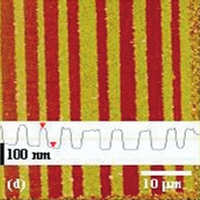
Miniaturization of ferroelectrics domains for non-volatile memory applications
Unlike commom dielectric materials, ferroelectrics remain polarized (display an electrical polarization) even in the absence of an electric field. Moreover, this polarization can be switched with an electric field from positive (up) to negative (down) by changing the sign of the applied voltage. This makes ferroelectrics very useful as memory bits.
Indeed, ferroelectric random access memories (FeRAM) are already in the market in many familiar devices such as Samsung cellphones or the Play Station 2. However, to increase the storage memory density to 1Tbit/in2, as required in many applications, is still an issue. To achieve that goal smaller and smaller ferroelectrics, with a size of about 25nm x 25nm, need to be built. In this project we want to explore the possibility of reducing the size of the ferroelectric bits by controlling the size of the ferroelectric domains that are intrinsically formed in thin films. In order to electrically address the bits, they will be electroded using a novel technique called "ferroelectric nanolithography" (see figure above). This technique allows to define smaller patterns than those achieved by standard lithographic techniques.
If you are interested in joining us with this project, please contact prof. dr. Beatriz Noheda.
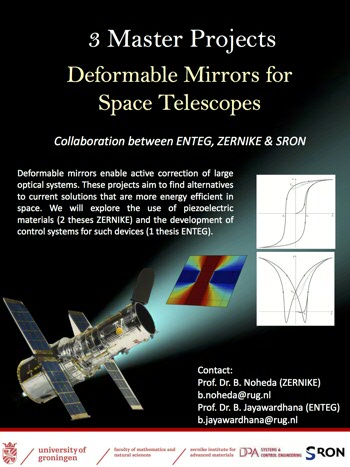
Piezoelectric materials in deformable mirrors for space telescopes
Deformable mirrors enable active correction of large optical systems. As a collaboration between the Netherlands Institute for Space Research (SRON), the Engineering and Technology Institute Groningen (ENTEG) and the Zernike Institute for Advanced Materials (ZIAM), this project aims to find alternatives to current solutions that are more energy efficient in space.From the Zernike Institute we will explore the use of piezoelectric materials in two different but complementary master theses supervised by Prof. Beatriz Noheda. We search for students from the Applied Physics and Advanced Materials programmes.
If you are interested in joining us with this project, please contact prof. dr. Beatriz Noheda.
Ferroelectrics as constituents materials for neuromorphic devices
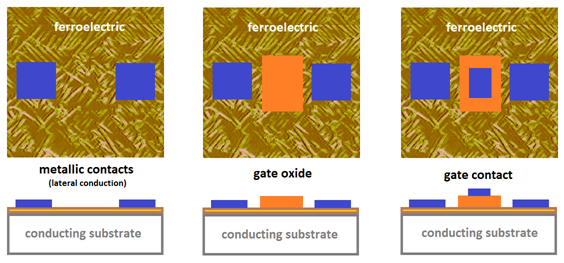
Neuromorphic computing is an intense branch of research trying to emulate some human-brain-features in order to get a more efficient memory reservoir. It is not only related with downsizing but also with the requirement of overcoming the bottle neck to access the data storage. Many challenging properties are supposed to be achieved in order to produce the change of paradigm the electronic industry is waiting for. Among them, materials showing multilevel states are candidates to take part in such new architecture.
Based on our group skills on ferroelectric materials, we propose them to achieve the multilevel requirement as part of novel devices with additional degrees of freedom.
If you are interested in joining us with this project, please contact prof. dr. Beatriz Noheda.
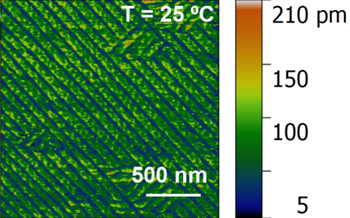
Study of ferroelastic domains evolution for adaptable electronics
Recently multiple studies have suggested that neural networks dynamics have the natural tendency to evolve towards regimes at the boundary between order and disorder, which is believed to be crucial for the brain ability to adapt. The concept of “edge of chaos” is well-known and is mathematically described by periodicity doubling cascades and bifurcation theory. Ferroelectric, magnetic and elastic domains are interesting examples of periodic structures in space.
In this project, we aim to explore the evolution of the periodicity of ferroelastic domains close to phase transition and exploit it to develop materials with enhanced electronic adaptability. In particular, we want to focus on the observation ferroelastic domains related by 2n, which is a signature of branching mechanism and bifurcation. In order to do so, ferroelastic thin films will be prepared by pulsed laser deposition and characterized via temperature dependent piezoresponse force microscopy (PFM), that will reveal the boundaries between adjacent domains.
If you are interested in joining us with this project, please contact prof. dr. Beatriz Noheda.
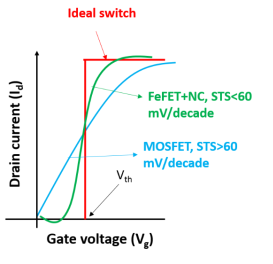
Exploring silicon-compatible ferroelectricity, and negative capacitance
House-hold electronic devices consume what is called “vampire power” even in the stand-by mode (or when the power is switched off). Vampire power can be traced back to leakage currents in transistors (building blocks of all electronics) when they are being operated in the OFF state. This leakage current is a result of thermodynamic limitation on the transistors, which cannot switch from an OFF to an ON state sharper than 60 mV(of gate voltage)/decade (of drain current). So getting rid of it, at a materials level involves “beating thermodynamics”. One way to do this is to use a gate oxide with so-called “negative capacitance”. This idea has been recently realized in ferroelectric materials and features such as domain boundaries, interfaces etc. The only problem with implementing standard ferroelectric materials in real devices is their compatibility with Si.
In our group we started exploring ferroelectricity in Si compatible simple oxide systems such as doped HfO2 through strain engineering. We are also trying to understand the origins of negative capacitance (and its apparent contradictions with thermodynamics) and materials features responsible for it. This understanding will lead us to design and fabricate negative capacitance FETs and characterize them.
If you are interested in joining us with this project, please contact prof. dr. Beatriz Noheda.
